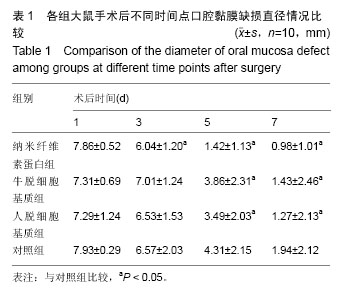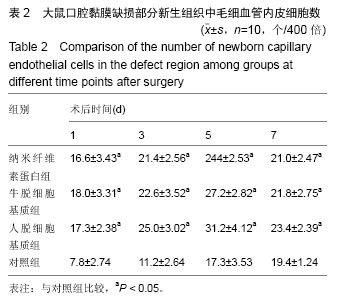| [1] Chiafini A, Petrini P, Bozzini S, et al. Silk fibroin/Poly (carbonate)-urethane as a substrate for cell growth: in vitro interactions with human cells. Biomaterials. 2003; 24(5):789-799.[2] 王海燕,周咏梅,吴岚,等.以胶原膜为支架构建组织工程化人口腔黏膜研究[J].临床口腔医学杂志, 2009,25(8): 494-496.[3] Chen LL, Hu GF. Angiogenin-mediated ribosomal RNA transcription as a molecular target for treatment of head and neck squamous cell carcinoma. Oral Oncol. 2010;46(9):648-653.[4] 姜大朋,李昭铸,张玉波.肌成纤维细胞在创伤愈合中的地位和作用[J].中国临床康复, 2006,10(13): 158-160.[5] Wang SD, Zhang YZ, Wang HW, et al. Fabrication and properties of the electrospun polylactide/silk fibroin gelatin composite tubular scaffold. Biomacromolecules. 2009;10(8):2240-2244.[6] 刘春晓,陈伟豪,郑少波,等.丝素蛋白膜对犬不同长度尿道缺损的修复效果[J].中国组织工程研究与临床康复, 2008, 12(19):3613-3616.[7] Zulkifli FH, Jahir Hussain FS, Abdull Rasad MS, et al. Improved cellular response of chemically crosslinked collagen incorporated hydroxyethyl cellulose/poly (vinyl) alcohol nanofibers scaffold. J Biomater Appl. 2015;29(7):1014-1027.[8] 张文元,杨亚冬,房国坚.壳聚糖-丝素复合支架材料与骨髓间充质干细胞相容性的研究[J].中国卫生检验杂志, 2010, 20(12):3084-3086.[9] 王世清,范志海,沈忆新.不同部位取材的雪旺细胞培养与纯化研究[J].中国修复重建外科杂志,2011,(2):23-31.[10] 苗宗宁,潘宇红,祝建中,等.丝素蛋白支架材料复合骨髓间充质干细胞构建组织工程化软骨[J].中国组织工程研究与临床康复,2008,12(27):5243-5247[11] 刘春晓,陈伟豪,郑少波,等.丝素蛋白膜对犬不同长度尿道缺损的修复效果[J].中国组织工程研究与临床康复, 2008, 12(19):3613-3616.[12] 荆恒,李宁毅,谭帅,等.骨髓基质干细胞的体外培养及其细胞片层制备[J].国际口腔医学杂志,2010,37(3):272-274.[13] 韩冰,付小兵.间充质干细胞的研究进展与临床应用前景[J].中国修复重建外科杂志,2006,20(12):1257-1261.[14] 李玮,孟雪梅.牙周组织工程种子细胞及其体内移植方法的研究进展[J].中国修复重建外科杂志,2010,24(10):1249-1252.[15] Packer C, Boddice B, Simpson S. Regenerative medicine techniques in cardiovascular disease: where is the horizon? Regen Med. 2013;8(3):351-360.[16] Du CH, Li NY, Gao N, et al. A preliminary study on the application of bone marrow stromal cell sheet on the formation of functional tissue-engineered bone in dogs. J Oral Maxillofac Surg. 2013;71(9):1531.[17] Gao Z, Chen F, Zhang J, et al. Vitalisation of tubular coral scafolds with cell sheets for regeneration of long bones: a preliminary study in nude mice. Br J Oral Maxillofac Surg. 2009;47(2):116-122.[18] Tatsumi T, Sugimoto M, Lillicrap D, et al. A novel cell-sheet technology that achieves durable factor VIII delivery in a mouse model of hemophilia A. PLoS One. 2013;8(12):e83280.[19] Li D, Wang W, Guo R, et al. Restoration of rat calvarial defects by poly (lactide-co-glycolide)/hydroxyapatite sca olds loaded with bone mesenchymal stem cells and DNA complexes. Chin Sci Bull. 2012;57(5):435-444.[20] Yan H, Tsujii K. Thermo-responsive poly (N-isopropylacrylamide)gel containing polymeric surfactant poly (2-(methacryloyloxyl) decylphosphate): correlation between rapid collapsing characters and micelles of polymeric surfactant. J Oleo Sci. 2008; 57(7): 401-405.[21] Tang Z, Akiyama Y, Okano T. Recent development of temperature responsive cell culture surface using poly (N-isopropylacrylamide). J Polymer Sci Part B. 2014; 52(14):917-926.[22] Elloumi-Hannachi I, Yamato M, Okano T. Cell sheet engineering: a unique nanotechnology for sca old-free tissue reconstruction with clinical applications in regenerative medicine. J Intern Med. 2010;267(1): 54-70.[23] 郑先雨,何家才.组织工程化口腔黏膜支架材料的研究进展[J].国际口腔医学杂志,2008,35(S1):198-201.[24] 张剑英,付云,俞少杰.人牙周韧带细胞膜片的体外实验研究[J].中华口腔医学研究杂志(电子版),2013,7(1):31-34.[25] 李霞.牙周膜细胞膜片的构建及脂肪干细胞向内皮细胞分化的初步研究[D].天津:天津医科大学,2012.[26] Tsumanuma Y, Iwata T, Washio K, et al. Comparison of different tissue-derived stem cell sheets for periodontal regeneration in a canine 1-wall defect model. Biomaterials. 2011;32(25):5819-5825.[27] Burillon C, Huot L, Justin V, et al. Cultured autologous oral mucosal epithelial cell sheet (CAOMECS) transplantation for the treatment of corneal limbal epithelial stem cell de ciency. Invest Ophthalmol Vis Sci. 2012;53(3):1325-1331.[28] 姚超,卜令学,王科,等.应用细胞片层技术构建组织工程骨修复犬下颌骨缺损的实验研究[J].华西口腔医学杂志, 2012, 30(3):229-233. |
.jpg)



.jpg)
.jpg)